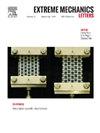Molecular Velcro for characterizing hydrogel coating adhesion
IF 4.5
3区 工程技术
Q2 MATERIALS SCIENCE, MULTIDISCIPLINARY
引用次数: 0
Abstract
Rapid advances in hydrogel adhesion have enabled the development of hydrogel coating on various substrates for lubrication, drug delivery, and anti-fouling paints. The quality of adhesion between hydrogel coating and substrate is important in applications, but has been shown to be extremely challenging to assess. Here we develop a general approach to characterizing the adhesion of hydrogel coating, called the molecular Velcro. Such Velcro is a stiff layer, to which polymer chains are grafted through covalent interlinks, and adheres to hydrogel through non-covalent interlinks. We prepare a 35 μm-thick hydrogel coated on a rigid substrate, introduce a pre-cut crack to their interface, and use the molecular Velcro as backing layer to measure the adhesion toughness by 90-degree peel. As the non-covalent adhesion between the molecular Velcro and the hydrogel is instant and tough, and does not affect the mechanical properties of the hydrogel, the crack grows along the interface between the hydrogel and the substrate, or kinks into the hydrogel. Consequently, the adhesion between the hydrogel coating and the substrate is precisely characterized at various coating thicknesses, peel velocities, and crosslink densities. To show the robustness of our approach, we further measure the adhesion toughness of several types of 50 μm-thick hydrogels coated on the same substrate. This work will guide the characterization of adhesion of soft and wet coatings.
表征水凝胶涂层附着力的分子魔术贴
水凝胶粘附的快速发展使得水凝胶涂层在各种基材上的发展成为可能,用于润滑、药物输送和防污涂料。水凝胶涂层与基材之间的粘附质量在应用中很重要,但已被证明是极具挑战性的评估。在这里,我们开发了一种通用的方法来表征水凝胶涂层的附着力,称为分子魔术贴。这种尼龙搭扣是一种刚性层,聚合物链通过共价连接接枝,并通过非共价连接附着在水凝胶上。我们制备了一层35 μm厚的水凝胶包覆在刚性基体上,在其界面上引入预切裂缝,并使用分子维可牢作为衬底层,采用90度剥离法测量了水凝胶的粘附韧性。由于分子维可牢与水凝胶之间的非共价粘附是瞬间的、坚韧的,并且不影响水凝胶的力学性能,因此裂缝沿着水凝胶与底物之间的界面生长,或者扭入水凝胶。因此,在不同的涂层厚度、剥离速度和交联密度下,水凝胶涂层与基材之间的粘附性得到了精确的表征。为了证明我们方法的稳健性,我们进一步测量了几种50 μm厚的水凝胶涂覆在同一基底上的粘附韧性。这项工作将指导软性和湿性涂层的附着力表征。
本文章由计算机程序翻译,如有差异,请以英文原文为准。
求助全文
约1分钟内获得全文
求助全文
来源期刊

Extreme Mechanics Letters
Engineering-Mechanics of Materials
CiteScore
9.20
自引率
4.30%
发文量
179
审稿时长
45 days
期刊介绍:
Extreme Mechanics Letters (EML) enables rapid communication of research that highlights the role of mechanics in multi-disciplinary areas across materials science, physics, chemistry, biology, medicine and engineering. Emphasis is on the impact, depth and originality of new concepts, methods and observations at the forefront of applied sciences.
 求助内容:
求助内容: 应助结果提醒方式:
应助结果提醒方式:


